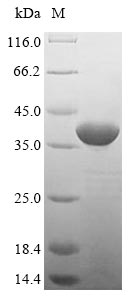This Saccharomyces cerevisiae YNK1 recombinant protein was produced in E.coli, where the gene sequence encoding Saccharomyces cerevisiae YNK1 (1-153aa) was expressed with the N-terminal 10xHis-SUMO tag and C-terminal Myc tag. The purity of this YNK1 protein was greater than 85% by SDS-PAGE.
Ynk1 protein typically possesses a catalytic domain associated with the nucleoside diphosphate kinase family. Its function can vary depending on the physiological state and needs of Saccharomyces cerevisiae cells. Ynk1 is a nucleoside diphosphate kinase, and it plays an important biological role in Saccharomyces cerevisiae cells. Similar to other nucleoside diphosphate kinases, Ynk1 is responsible for catalyzing the reaction of nucleoside diphosphorylation, converting a nucleoside monophosphate into a nucleoside diphosphate. This process plays a crucial role in nucleoside metabolism within the cell and is closely associated with processes like energy transfer and DNA synthesis. Furthermore, one of the primary biological roles of Ynk1 is to maintain the production of ATP within Saccharomyces cerevisiae cells. ATP is the cell's primary energy molecule, supplying energy for various biological processes such as cell division, protein synthesis, and transportation.






